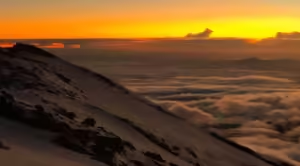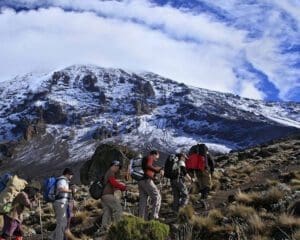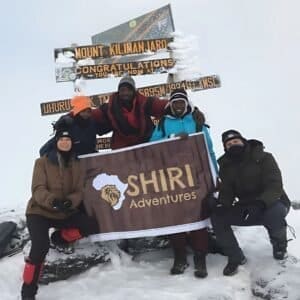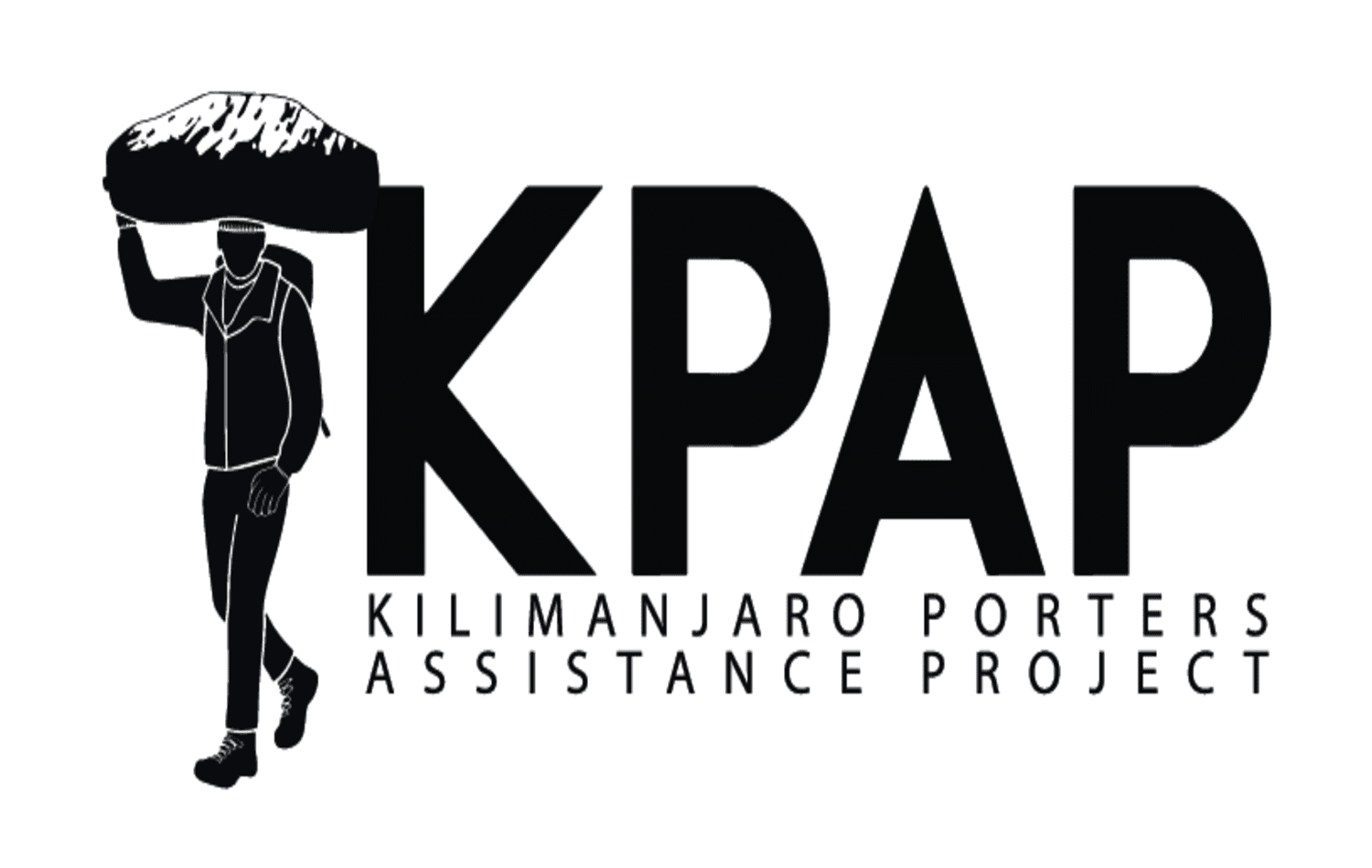/PAX
Mount Kilimanjaro, Africa’s highest peak, is a dream destination for many. It’s a place of breathtaking beauty and immense challenge. The Lemosho route, one of the many paths to the summit, is gaining popularity among climbers. It’s known for its scenic beauty and higher success rates.
This guide is designed for those planning an 8-day trek on the Lemosho route. It aims to provide a comprehensive overview of what to expect, how to prepare, and tips for a successful climb.

The Lemosho route offers a unique experience. It starts on the western side of the mountain and traverses across to the east, providing diverse landscapes and wildlife spotting opportunities. The 8-day option is particularly beneficial for acclimatization. It allows more time for your body to adjust to the altitude, increasing your chances of reaching the summit.
Choosing the right trekking company is crucial. They can make or break your experience. This guide will help you understand the importance of choosing a reputable company and the costs involved. Physical preparation is another key aspect. The trek is physically demanding, and proper training can make a significant difference. We’ll provide tips on how to prepare and what gear to pack.
Altitude sickness is a common concern among climbers. We’ll discuss its symptoms, prevention, and treatment.
The Lemosho route is not just about the physical challenge. It’s also about cultural interactions with local guides and porters, and understanding the significance of Kilimanjaro for the local communities.
Finally, we’ll talk about what happens after the trek. From recovery to receiving your certificate and exploring more of Tanzania, there’s plenty to look forward to.
Whether you’re an experienced climber or a novice adventurer, this guide will equip you with the knowledge you need for your 8-day Kilimanjaro trek via the Lemosho route.
Let’s embark on this journey together.
The Lemosho route is renowned for its stunning vistas and pristine landscapes. It’s less crowded than other routes and offers a more scenic trek. With lush rainforests and wide open moorlands, the Lemosho route is truly a feast for the eyes.
One of the biggest advantages of the Lemosho route is its high success rate. This is largely due to the gradual ascent, which helps climbers acclimatize effectively. As a result, trekkers have a better chance of reaching the summit, which for many is a lifelong dream.

Wildlife enthusiasts will also appreciate the Lemosho route. It traverses through diverse ecological zones rich in flora and fauna. Spotting animals like colobus monkeys in the rainforest is a real possibility, adding a layer of excitement to the journey.
For those seeking solitude and a more immersive experience, the Lemosho route is ideal. Starting on the western side of Mount Kilimanjaro, it is less frequented, allowing trekkers to enjoy the tranquility of nature. This makes for a more personal and reflective trekking experience.
Moreover, the Lemosho route offers a journey through culture. Encounters with local guides and porters provide insight into the customs of the Chagga people. These interactions enrich the trek, providing memorable cultural exchanges along the way.
In summary, the Lemosho route is a top choice for many reasons. Its beauty, wildlife, cultural experiences, and high summit success rate make it an exceptional path to the peak of Kilimanjaro.
Embarking on the 8-days-kilimanjaro-trek-lemosho-route is an adventure of a lifetime. The journey offers a perfect combination of challenge and breathtaking beauty. This extended trek allows ample time for acclimatization, promoting higher success rates.
Climbers typically cover around 42 miles over eight days on this trek. Each day brings its own landscapes, from dense forests to alpine deserts. This diversity is one of Kilimanjaro’s greatest treasures.
The route starts at Londorossi Gate, one of Kilimanjaro’s lesser-used entrances. This beginning ensures trekkers have a private start compared to other crowded routes. It’s a serene kick-off to a grand adventure.
As you ascend, eight-day treks give additional time at altitude. This pacing is crucial in preventing altitude sickness. Proper acclimatization can be the key to reaching Uhuru Peak successfully.
Not only does the Lemosho route offer stunning scenery, but it also provides encounters with wildlife. Trekkers may spot animals like colobus monkeys and diverse birds. These sightings enhance the overall trekking experience.
Day 1: Arrival and Preparations
On the first day, you arrive in Tanzania, usually at Kilimanjaro International Airport. The excitement is palpable as you travel to your hotel for the night. Here, guides give a detailed briefing and check your gear.

Day 2: Lemosho Gate to Mti Mkubwa Camp
The real adventure begins as you head to Londorossi Gate for registration. After formalities, the trek commences through lush rainforests, buzzing with life. Finally, you reach Mti Mkubwa Camp, where you spend the night.
Day 3: Mti Mkubwa Camp to Shira 1 Camp
The trail opens into moorlands, offering spectacular vistas. Your path takes you across the Shira Ridge. By evening, you arrive at Shira 1 Camp, where you soak in the expansive views.

Day 4: Shira 1 Camp to Moir Hut
Trekking across the Shira Plateau unveils vast landscapes. The trail weaves through low-lying plants and volcanic formations. You reach Moir Hut, offering a haven amid rugged terrain.

Day 5: Moir Hut to Barranco Camp
Continuing upwards, trekkers tackle the expansive expanse leading to Lava Tower. Acclimatization occurs naturally at higher altitudes before descending to Barranco Camp. Here, the Great Barranco Wall looms in the background.
Day 6: Barranco Camp to Karanga Camp
The day starts with a challenging climb up the Barranco Wall. Steep and daunting, it’s an exhilarating stretch. After triumphing over the wall, you navigate rolling hills to reach Karanga Camp.
Day 7: Karanga Camp to Barafu Camp
Your journey ascends towards Barafu Camp, the base before summit night. The route exposes trekkers to arid conditions, yet spirits run high. By evening, preparations commence for the summit push.

Day 8: Barafu Camp to Summit and Descent to Mweka Camp
Summit night is challenging, starting at midnight. You ascend to Uhuru Peak as dawn breaks, achieving the trek’s ultimate goal. After celebrating, you descend to Mweka Camp, reflecting on your achievement.
Preparation is key to a successful Kilimanjaro trek via the Lemosho route. Both physical fitness and mental readiness are critical. They enhance your chances of reaching the summit.
Training should begin several months before your trek. Conditioning your body is vital for enduring long days of hiking. Start incorporating aerobic exercises, like running or cycling, into your routine.
Complement cardio workouts with strength training. This helps build muscle endurance needed for mountainous terrain. Squats, lunges, and core exercises can be extremely beneficial.
Equally important is familiarizing yourself with your gear. Practice carrying your daypack on hikes. This ensures you’re comfortable managing its weight.
A well-planned packing list is a trekker’s best friend. Packing the right gear can significantly affect your comfort and safety. Ensure you have layers for varying weather conditions.
Remember, acclimatization starts long before the trek. Taking time to rest and adapt during training helps your body adjust. This can reduce risks of altitude sickness on the mountain.
Lastly, consider consulting a healthcare provider. Discuss vaccinations and preventative medicines, like malaria prophylaxis. Thorough preparation minimizes health risks during the trek.
An essential part of preparing for an 8-days-kilimanjaro-trek-lemosho-route is physical training. Building stamina will make your trek more enjoyable. Aim for a good balance of cardiovascular and strength exercises.
Focus on exercises like hiking, walking, and jogging. These will improve your cardiovascular endurance. Try to include uphill hikes for better preparation.
Strength training is equally important. Exercises should target your legs, core, and upper body. Consider incorporating these into your routine:

Consistency is key, so aim for regular workouts three to four times a week. As your trek date nears, try to simulate trek conditions by wearing your gear. By building your fitness steadily, you can face Kilimanjaro’s challenges with confidence.
Packing correctly for the Lemosho route can make a significant difference. Essential items help protect against the unpredictable mountain conditions. Begin with a focus on quality over quantity.
Layering is crucial; it offers flexibility in response to temperature changes. Pack moisture-wicking base layers, insulating mid-layers, and a waterproof jacket. These will keep you comfortable across various climates.
A good pair of durable, waterproof hiking boots is indispensable. They should provide ample support and have been broken in beforehand. The right footwear can prevent blisters and enhance comfort.

Aside from clothing, ensure you carry essential equipment. A well-stocked daypack is necessary, including hydration systems and personal items. Here’s a suggested list:
Remember, Kilimanjaro gear rentals are available in Tanzania. This is convenient if you prefer not to purchase. Packing smart is essential to a successful and enjoyable trek.
Altitude sickness is a common concern on the Kilimanjaro trek. Understanding its symptoms and prevention is vital for safety. Headaches, nausea, and dizziness are early signs to watch for.
Acclimatization is the best defense against altitude sickness. The Lemosho route’s gradual ascent aids this process. Taking your time, or “pole pole” as locals say, is crucial. Slow ascent allows your body to adjust better to thinner air.
Hydration also plays a key role. Drinking plenty of fluids helps you acclimate. Aim for three to four liters per day. Avoid alcohol and caffeine since they can worsen dehydration.

Listen to your body’s cues during the trek. Rest if you feel unwell, and communicate symptoms to your guide. Guides are trained to recognize altitude sickness signs and can offer assistance.
Safety is paramount, and preparedness goes a long way. Carry necessary medications, such as Diamox, and have a solid first aid kit. Trekking companies often provide oxygen support for emergencies, but prevention is best.
Finally, choose a trekking company wisely. Reputable companies prioritize trekkers’ safety and offer experienced guides. Their expertise can make a significant difference in managing health on the mountain.
Selecting the right trekking company is crucial for a memorable Kilimanjaro trek. A reliable company provides a safe, enjoyable, and well-organized experience. Look for well-established companies with strong reputations and numerous positive reviews.
Research is key when choosing your guide service. Consider their success rates, which reflect safety and expertise. Experienced guides understand the challenges trekkers face on the Lemosho route. They offer valuable advice and support throughout the journey.

Transparency in pricing is important when evaluating costs. The cost of an 8-day Kilimanjaro trek via the Lemosho route can vary widely. Ensure the package includes park fees, meals, camping gear, and guide services. Some companies offer price reductions for group bookings.
Understand what isn’t included in the listed price. Additional expenses like tips, personal gear rental, and flights add to overall costs. It is also wise to budget for emergency expenses. Insurance covering high-altitude trekking is often a requirement but typically not included in package costs.
Lastly, consider the ethical impact of your choice. Opt for companies that treat their staff well and respect ethical labor practices. Companies committed to fair wages and porter welfare not only enhance your experience but support the local economy.
Timing your trek on Kilimanjaro is crucial for success and enjoyment. The best months generally include January to mid-March and June to October. These periods coincide with mild weather and clearer skies.
During these months, the trails are more accommodating. You encounter less rainfall and more stable weather, which aids acclimatization. However, these months are also the busiest, so consider booking in advance.

Avoid trekking during the long rainy season from March to May. Trails become slippery and visibility is reduced, increasing the challenge. Temperatures at higher elevations remain cold year-round, requiring proper gear.
The short rainy season in November should also be approached with caution. Conditions vary, with afternoon rains possible on most days. Even in the dry season, be prepared for varied climates ranging from tropical at the base to arctic at the summit.
Embarking on the 8-days-kilimanjaro-trek-lemosho-route extends beyond just a physical journey; it offers cultural exploration. The guides and porters are often from local communities, bringing rich cultural insights. Many of these individuals are from the Chagga or Maasai tribes, each with unique traditions and stories.

The guides are not only skilled navigators but also cultural ambassadors. They share fascinating tales of Kilimanjaro’s history and their personal experiences. These exchanges enhance your journey, deepening your connection to the landscape and its heritage.
Porters, vital for the trek’s success, carry supplies and set up camps. Their hard work ensures a smooth trek, allowing you to focus on the climb and the experience. Observing their stamina and efficiency is a lesson in itself, highlighting their importance to the local economy and the trekking industry.
Engaging with local communities before or after your trek adds another layer to your journey. Visiting local markets or learning a few Swahili phrases can create meaningful interactions. Respect and open-mindedness enrich these cultural experiences, offering glimpses into the lives of those who call the Kilimanjaro region home.
Completing the 8-days-kilimanjaro-trek-lemosho-route is a remarkable achievement. Once you descend, taking time to rest and recuperate is essential. The trek takes a toll on your body, so a few days of relaxation can work wonders.

After resting, you might consider some pampering. Many trekkers opt for massages or spa treatments to soothe tired muscles. These services are available at many hotels and lodges, providing a blissful recovery experience after the challenge of Kilimanjaro.
Your climb’s success is acknowledged with a certificate. This memento serves as a proud reminder of the adventure and the triumph of reaching the summit. Display it as a testament to your perseverance and strength.
After your Kilimanjaro adventure, explore more of Tanzania. Consider a safari in the Serengeti or a relaxing retreat on Zanzibar’s beaches. Both offer a stark contrast to the mountain climb and are perfect post-trek experiences. Combining these adventures can make your trip unforgettable, showcasing Tanzania’s diverse beauty and allure.
Conquering the Lemosho Route on Mount Kilimanjaro is a transformative journey. It tests your limits and rewards you with breathtaking vistas and profound personal growth. This 8-days-kilimanjaro-trek-lemosho-route represents not just a physical conquest but a mental triumph as well.

Every step you take on this trek brings you closer to nature and your innermost self. The ascent challenges you, yet the views inspire resilience. Completing the Lemosho Route etches memories of sheer wonder. It’s an achievement of a lifetime, worth every ounce of effort.



TERMS AND CONDITIONS | AFRICAN SAFARI | PRIVACY POLICY | REFUND POLICY | FOR TRAVEL AGENCIES | HOTELS IN TANZANIA | OUR BLOG
© 2025 Shiri Adventures